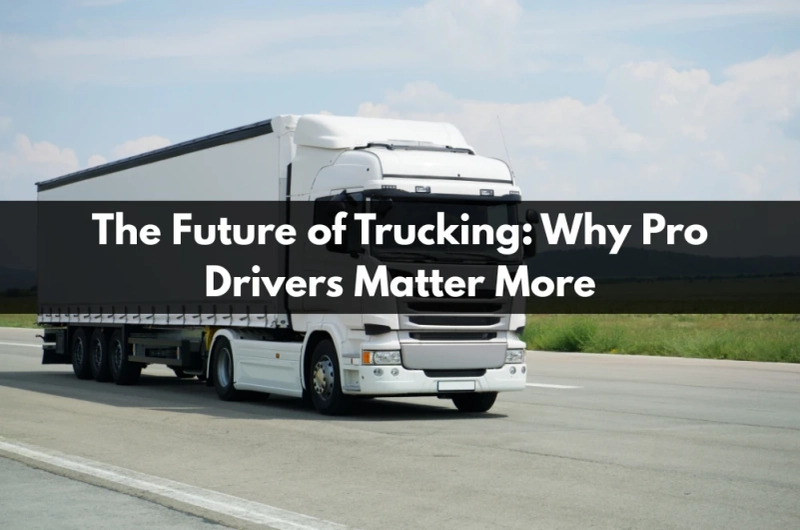Freight is getting faster, heavier, and more connected—and that puts human judgment squarely back in the spotlight. When loads are time-sensitive and weather shifts mid-run, experience beats guesswork. Getting there starts with solid foundations: machine control, hazard scanning, and calm crisis habits. Enrolling in a professional truck licence course gives structure to those skills without the bloat, so every hour in the cab turns into a safer kilometre on the road. I’ve watched trainees who practise deliberately—mirror discipline, smooth throttle—become the drivers you want beside you in a storm. The future needs more of that: steady hands, fewer close calls, and fleets that run on predictability.
What’s changing in trucking work
Telematics, dynamic routing, and heavier vehicle tech promise productivity, but they make attention management harder. The job now is part pilotage, part logistics, part steady temperament when the headset crackles and the sky opens. For many entering the industry or upgrading to a truck licence in NSW, understanding these shifts is key to staying safe and efficient on the road.
- Real-time pressure: Algorithms shift routes mid-trip, which demands calm task switching and clear radio etiquette when plans change.
- Heavier combinations: Longer, heavier configurations increase stopping distances, so hazard scanning must happen seconds earlier.
- Weather volatility: Flash storms and crosswinds test load security, requiring measured steering and speed discipline rather than last-second corrections.
- Urban pinch points: Construction detours and micro-windows for deliveries raise stress; deliberate planning protects patience and panels alike.
A modern rig is a cockpit with mirrors. The drivers who thrive are the ones who make small, boring decisions well—over and over—until the tough conditions feel routine.
Licensing and standards for safer roads
Licensing isn’t a hoop to jump through; it’s a safety net for everyone sharing the lane. The pathway guides you from fundamentals to advanced judgment, and it keeps the training map honest.
- Competency scaffolding: Categories step up complexity, ensuring drivers can handle mass, length, and braking behaviour progressively.
- Medical fitness: Health checks protect drivers and the public, because fatigue and untreated conditions magnify risk at highway speeds.
- Load restraint literacy: Knowing the numbers behind tie-downs and friction turns anxiety into a method when the deck is full.
- Compliance culture: Recording defects and reporting near-misses builds fleets that learn quickly without blame.
If you’re mapping your steps, official guidance on getting a heavy vehicle licence lays out the categories, prerequisites, and verification you’ll need. In my own notes, having the stages in one place turned “someday” into a plan with dates, checklists, and a calm test day.
Training that actually translates on the road
Not all practice sticks. The drills that change behaviour are short, repeatable, and measured. They focus on sensations—engine note, brake feel, trailer tracking—so judgment gets quicker without getting rash.
- Deliberate reps: Short manoeuvre sets (offset reverse, precision stop) build muscle memory that holds up when rain smears mirrors.
- Feedback loops: Cab-mounted video and instructor notes beat hunches, turning “I think I was wide” into “I clipped cone three by 20 cm.”
- Fatigue rules: Planned breaks and micro-stretches protect reaction time; alert drivers save fuel and stress.
- Emergency drills: Practising engine-off stops and low-traction launches keeps surprises small when conditions slide.
For step-ups into bigger combinations, understanding prerequisites before booking saves dead ends. A clear checklist for applying for an MC licence keeps your course timeline clean and your wallet safe. I’ve coached learners who shaved weeks off by prepping documents and reading the finer points early.
Career pathways and retention in transport
Keeping skilled people matters more than shiny hardware. When drivers feel growth ahead of them, fleets keep wisdom in the cab and costs down at the workshop.
- Structured mentoring: Pairing fresh drivers with seasoned hands in a formal plan turns stories into skills and shrinks rookie error rates.
- Upskill ladders: Clear steps—from smaller rigs to multi-combination—keep ambition anchored to safety.
- Health and recovery: Movement, stretches, and sleep plans reduce injuries and sick leave, which is good for drivers and dispatchers.
- Admin clarity: Clean rostering and predictable pay cycles build trust; trust keeps the best people in uniform.
If you’re mapping the first few years, knowing how to start your career with truck driver licence essentials helps you see how licences, endorsements, and on-road experience stack together. I still remember a mentored night run down a wet escarpment—quiet coaching, steady pedal, and a lesson you can’t learn on a dry pad.
Technology that helps rather than distracts
New tools can either sharpen focus or scatter it. The trick is choosing systems that reduce cognitive load, not add dashboard noise.
- Driver-first telematics: Alerts that speak in plain language and sensible timing prevent alarm fatigue.
- Vision aids: Calibrated cameras and clean mirrors beat gadget sprawl; clarity beats quantity when seconds matter.
- Predictive maintenance: Sensor-driven servicing catches issues before roadside dramas, saving time and frayed tempers.
- Route realism: Software that knows bridge heights, local curfews, and ramp grades keeps cabs away from trouble.
The best setups feel quiet. They nudge rather than nag, and they leave the big decisions to the person holding the wheel.
Bringing it together for the next decade
Professional drivers will be the difference between networks that fray under pressure and those that glide. The work asks for steady temperament, methodical habits, and respect for weight and weather. Start with foundations: a good course, a clean licensing map, and cab time that focuses on feel rather than flash. Build a notebook you actually use—checklists for coupling, quick sketches for blind-side moves, and fuel logs that teach you where you waste effort. Then add career rungs you can climb safely: endorsements that make you more useful to dispatch and more confident in tight spots. Keep your body in the plan—hydration, stretches, sleep—and you’ll erase more risks than any gadget can. Finally, choose tech that lowers stress, not raises it, and ask for rosters that honour recovery so your reactions stay sharp. That’s how drivers become the quiet backbone of freight: fewer near-misses, calmer runs, and fleets people are proud to be part of. It’s not glamorous, but it is the future—reliability shaped by skill.



